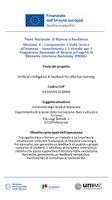|
The Artificial Intelligence and Feedback for Effective Learning project aims to provide a method, a friendly interface and related tutorials to use free Open Source Machine Learning Frameworks for educational feedback purposes to ensure quality feedback for large students groups. The overarching aim is to build a system that can support effective learning being in any case sustainable.
The project intends thus to use technology to capture aspects and identify similarities that a human agent might not notice.
The project, based on desk and field data, will provide instruments for using the free Open Source Machine Learning Frameworks by teachers and students. The design and development phase will enable universities to pilot in real settings to test functioning, reliability, perceived relevance and usefulness for learning purposes by teachers and learners. Furthermore, data collected will allow to
a) refine the model of the use of the software for feedback purposes; b) validate the aspects and processes which resulted in successful effective learning;
c) identify potential development and associated elements that could emerge during the implementation over time.
Since the software will be used in different field subjects, variables related to contextual aspects, facets and attributes will be subject to analysis.
Scientific advancements include an increased capacity in the teaching and learning process to use feedback for effective learning also in large-size lecturers; technological advancements are related to increased understanding of human-machine interactions and availability of validated tools and procedures to use it in daily work.
|

